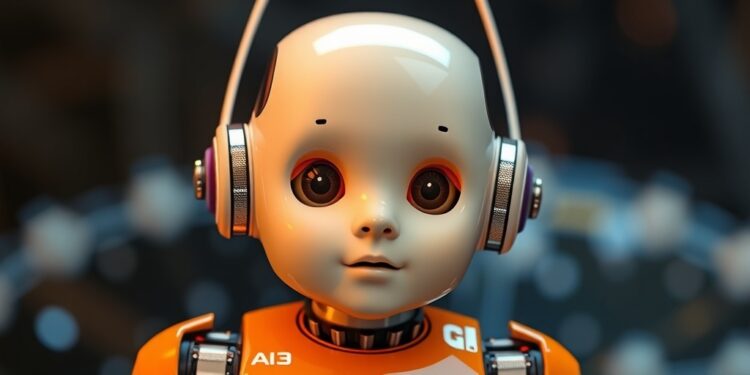
In a groundbreaking study recently published in the journal Science Robotics, researchers from the Cognitive Neurorobotics Research Unit at the Okinawa Institute of Science and Technology (OIST) have unveiled a revolutionary embodied intelligence model that sheds light on the complex mechanisms of generalization and compositionality in neural networks. This novel artificial intelligence architecture exhibits a remarkable ability to learn and adapt in a manner strikingly similar to how human toddlers acquire knowledge and language.
The study’s core focus is on understanding compositionality, the cognitive ability to combine concepts learned from distinct experiences into new scenarios. For instance, a child who learns to identify the color red through various red objects—be it a toy truck, a fruit, or a flower—can apply this understanding to a new red item upon encountering it for the first time. The researchers emphasize that this fundamental cognitive skill is key to broader learning processes, both in humans and artificial intelligence.
Traditional large language models (LLMs) primarily rely on vast datasets to identify patterns in language. These models, founded on transformer architectures, process textual information and generate outputs based on statistical relationships. Although remarkably powerful, these models often lack transparency due to their complexity, with trillions of parameters obscuring the inner workings and decision-making processes. As these models have evolved, so have the challenges of understanding how they arrive at their conclusions.
In contrast, the new model introduced by the OIST research team uses a Predictive coding inspired, Variational Recurrent Neural Network (PV-RNN) framework that embraces a fundamentally different approach. The PV-RNN is designed to integrate multiple sensory inputs simultaneously, which mirrors the experiences of a toddler learning through active engagement with the environment. By exposing the model to language instructions, visual data from robot arm movements, and proprioceptive feedback regarding joint angles, the researchers have created an embodied system capable of generating predictions and responses based on real-time experiences.
Underpinning this model is the Free Energy Principle, which posits that human cognition is fundamentally about minimizing discrepancies between expectations and sensory input. By embracing this principle, the researchers have designed a model that emulates human-like processing constraints, promoting sequential input updates rather than overwhelming the system with simultaneous data. This emulation provides researchers with unprecedented visibility into how the model learns and updates its internal representations, paralleling cognitive development in children.
As the researchers explored this model, they discovered several compelling insights. One particularly notable finding was that increased exposure to words in varied contexts significantly enhances the model’s ability to understand and utilize those words—mirroring the learning experiences of children. This reinforces the notion that diversity in interactions plays a critical role in language acquisition. Just as a child learns the concept of “red” more effectively through diverse experiences with different red items, the PV-RNN capitalizes on similar exposure to strengthen its knowledge base.
Interestingly, the results achieved by the PV-RNN suggest a more human-like error pattern compared to traditional LLMs. While the new model may make more mistakes overall, these errors closely resemble the types of misunderstandings that humans encounter, offering cognitive scientists rich insights into the nature of human learning. This resemblance is particularly valuable for those studying how autonomous systems can learn from experience in a way that aligns closely with human cognitive processes.
Moreover, the model adeptly addresses a critical dilemma known as the Poverty of Stimulus, which asserts that the linguistic input children receive is often insufficient to explain their rapid language acquisition. By grounding language learning in behavioral experiences rather than solely relying on textual data, the researchers assert that this embodied approach could elucidate critical factors behind children’s remarkable linguistic abilities.
The implications of these findings extend to the realm of artificial intelligence ethics and safety. The PV-RNN’s design ensures that it learns through actions that carry potential emotional weight, contrasting sharply with conventional LLMs, which absorb word meanings in a more abstract, detached manner. This characteristic emphasizes the importance of developing AI systems that possess a deeper understanding of the consequences of their actions, ultimately leading to safer and more transparent technologies.
Continued research will further enhance the model’s capabilities, and the OIST team is exploring various domains of developmental neuroscience to uncover additional insights. The work not only addresses fundamental questions within the fields of AI and cognitive science but also highlights the necessity of understanding the intricate processes that underpin language acquisition and learning.
As these researchers venture deeper into the mechanics of this embodied intelligence model, they expect to discover more about how humans integrate language with sensory interactions, revealing the fundamental processes that contribute to cognition. As concluded by Dr. Prasanna Vijayaraghavan, the model has already provided valuable insights into compositionality and language learning, indicating a promising path towards developing more efficient, transparent, and ethically responsible AI systems. This exploration of the intersection between consciousness and artificial intelligence underscores the significance of examining how cognitive processes unfold in the human mind, enriching our understanding of learning and intelligence.
Subject of Research: Cognitive Neuroscience and AI
Article Title: Development of compositionality through interactive learning of language and action of robots
News Publication Date: 22-Jan-2025
Web References: Not Available
References: Not Available
Image Credits: Not Available
Keywords: Cognitive Development, Language Acquisition, AI Learning, Compositionality, Neural Networks, Embodied Intelligence, Predictive Coding, Human-Centric AI, Child Learning Methods, Ethical AI Systems.
Tags: Cognitive Development in RoboticsCompositionality in Neural NetworksDevelopmental Cognitive NeuroscienceEmbodied Artificial IntelligenceEthical AI SystemsFree Energy Principle in AIHuman-Centric AI LearningLanguage Acquisition MechanismsPoverty of Stimulus in AIPredictive Coding ModelsRobot Sensory IntegrationVariational Recurrent Neural Networks





